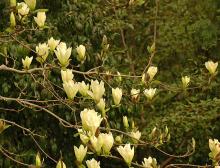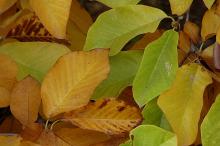Magnolia 'Elizabeth'
Common name:
Elizabeth Magnolia
Pronunciation:
mag-NO-li-a
Family:
Magnoliaceae
Genus:
Type:
Broadleaf
Native to (or naturalized in) Oregon:
No
- Broadleaf deciduous tree, to 25-30 ft (7.6-9 m) tall, about half as wide, pyramidal habit, rather upright. Leaves generally obovate, 12-23 cm long and 7-20 cm width, tip has a short, sharp, abrupt point (cuspidate), base wedge-shaped to rounded, margine entire, hairs concentrated on the veins, bright green upper surface with hairs confined to mid-vein alone. Flower buds are tapered and open to primrose-yellow blooms which appear before leaves. The plant patent states that the tepals (petals) are "clear yellow with the outermost whorl slightly tinged with green." Each of the 6-9 tepals is spatula-shaped with broad rounded tip, 7-9 cm in length and 2.5-5.0 cm in width. At maturity, the flower measures up to 8 cm across. As the flower opens, the tepals are shown to be undulate. Stamens are a rich yellow while the stigmas are paler. Pedicels are green and are up to 1 cm. long. The flowers are sterile.
- Sun.
- Hardy to USDA Zone 5 Developed in 1956 by Evamaria Sperber of the Brooklyn Botanic Garden, and named and patented (PP 4145) in 1977; after Elizabeth van Brunt, a Director and benefactor of the Garden. It is the result of a cross of P. acuminata × M. denudate.
- Jacobson (1996, p. 322-333) states that there are two clones cultivated under the name of 'Elizabeth', and that the "incorrect clone may be the more common." He continues that in the maritime Pacific Northwest 'Elizabeth' is a "flop", in that its "luminous yellow" of the open flower rapidly degrades to a "cold, creamy or greenish white." It also is susceptible to Botrytis, which stains the petals a dirty brown.
- Gardiner (2000, p. 211) states that the flower color of 'Elizabeth' is creamy yellow in the south of England, but more intense under strong light, "such as in South Korea and New Zealand."
- The Ohio Nursery and Landscape Association named Magnolia 'Elizabeth' to its selected plant list for 2002. Selections are made with the belief that these plants have undeveloped marketing potential.
- Oregon State Univ. campus: west side of Valley Library.








